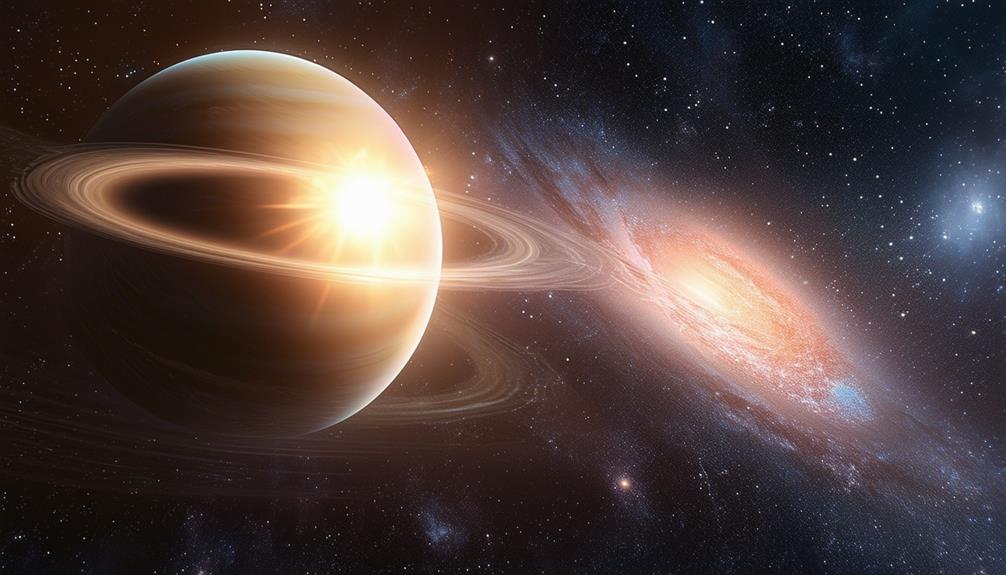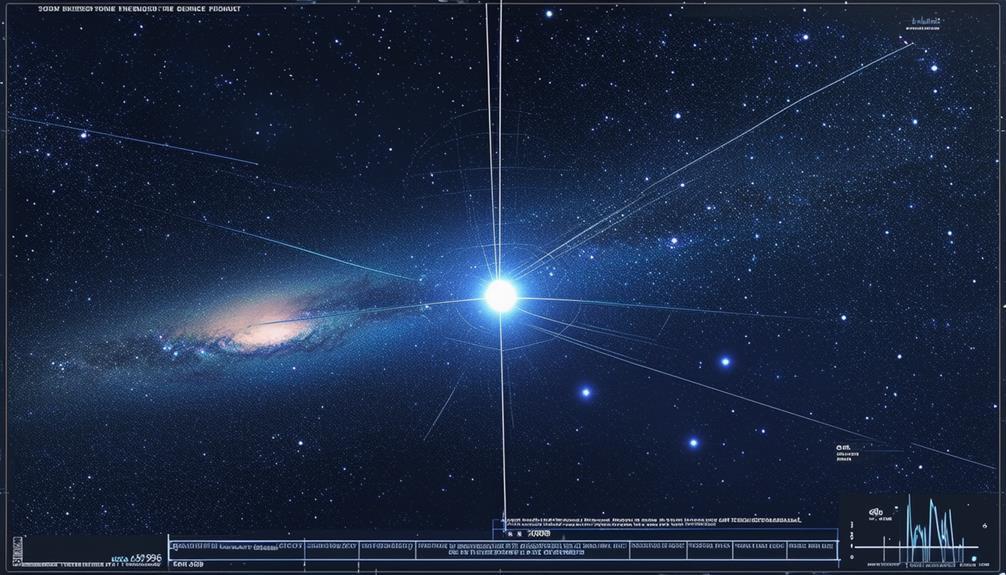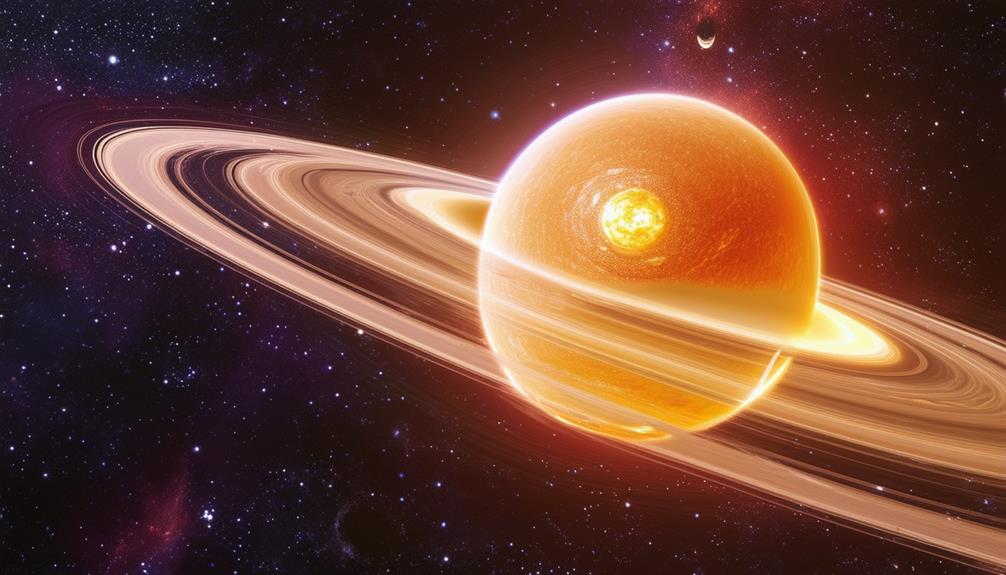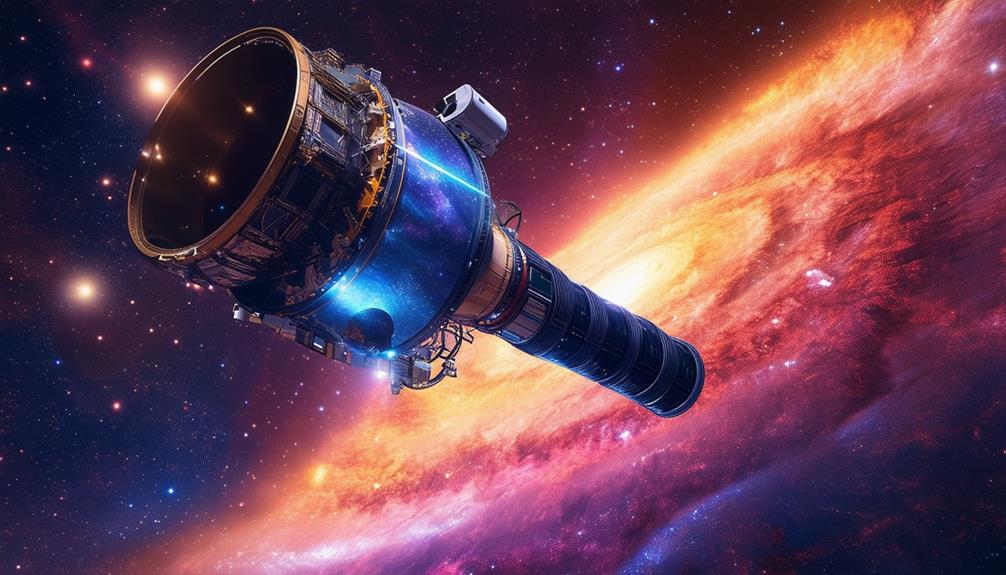The Techniques Used to Discover Exoplanets: Transit Method, Radial Velocity, and More

When you aim to understand how astronomers discover exoplanets, you encounter a range of fascinating techniques. The Transit Method detects planets by observing the slight dimming of a star as a planet crosses in front of it, providing clues about the planet's size and orbit. The Radial Velocity method measures the star's wobble caused by gravitational interactions, revealing information about the planet's mass and orbital path.
Additionally, methods like Gravitational Microlensing, which uses the bending of light from a distant star by a planet's gravity, and Direct Imaging, which captures actual images of the planet, offer unique insights. Each of these techniques contributes distinctively to the ongoing quest to find new worlds. Curious about how these methods work?
Transit Method
The Transit Method detects exoplanets by observing the temporary dimming of a star's light as a planet passes in front of it, a phenomenon known as a transit. When a planet orbits its star, it can move into a position where it blocks a portion of the starlight from reaching us. This blocking causes a slight dip in the star's brightness, which can be measured to confirm the presence of an exoplanet.
By analyzing the light curve—a graph of light intensity over time—you can determine the size of the planet and its orbital inclination. A larger planet will block more light, resulting in a deeper dip. Additionally, the frequency of these dips reveals the planet's orbital period.
The transit method is particularly effective at detecting large planets close to their stars, as they cause more noticeable dimming. Moreover, when a star's light passes through a planet's atmosphere during a transit, scientists can extract the planet's atmospheric spectrum. This information helps determine the planet's atmospheric composition and surface temperature.
Radial Velocity
The radial velocity method involves detecting the wobble of a star caused by the gravitational pull of orbiting planets. By analyzing the Doppler shifts in the star's spectral lines, this technique allows scientists to estimate the mass and orbital parameters of these exoplanets. It's particularly effective for identifying massive planets and can be applied in complex systems, including binary star systems.
Stellar Wobble Detection
Radial velocity, also known as stellar wobble detection, allows astronomers to measure a star's speed variations caused by orbiting planets. This method was pivotal in discovering the first exoplanet, 51 Pegasi b, in 1995.
By observing the star's subtle movements, scientists can infer the presence of planets that induce these wobbles. Massive planets, such as hot Jupiters, exert significant gravitational forces, causing the star to move in small circles or ellipses.
High-precision spectrographs are essential for detecting these tiny shifts in the star's spectrum, which indicate the presence of orbiting planets. The radial velocity method is particularly effective for identifying large, close-in planets like hot Jupiters, which create more noticeable wobbles in their host stars.
This technique not only helps in identifying exoplanets but also allows for determining their mass and orbital characteristics. Additionally, stellar wobble detection can be used to study planets in binary star systems. Analyzing these variations provides valuable insights into the dynamics of distant planetary systems.
Doppler Shift Analysis
By analyzing Doppler shifts in a star's spectrum, astronomers can detect the subtle movements indicative of orbiting planets. This approach, known as the radial velocity technique, measures the minute changes in a star's velocity as it moves towards or away from Earth.
When a planet orbits a star, the gravitational interaction causes the star to wobble slightly. This wobble affects the star's spectral lines, shifting them towards the blue end of the spectrum as the star approaches Earth, and towards the red end as it recedes.
High-precision spectrographs capture these radial velocity signals, providing critical insights into the existence and characteristics of orbiting planets. This method measures the velocity of the star relative to a fixed point, allowing astronomers to infer the presence of a planet even without direct observation.
The technique is particularly effective for identifying massive planets in close orbits around their stars. By tracking these spectral line shifts over time, astronomers can gather valuable data about the planet's orbit and its influence on the host star.
Exoplanet Mass Estimation
Astronomers utilize the radial velocity technique to estimate an exoplanet's mass by observing the variations in a star's velocity caused by the gravitational influence of an orbiting planet. When a planet orbits a star, it induces a slight wobble in the star, resulting in Doppler shifts in the star's spectrum that can be detected as changes in the star's velocity.
By analyzing these velocity fluctuations, astronomers can infer the presence of orbiting planets and estimate their masses. This method is especially effective for detecting massive planets in close orbits, as their stronger gravitational pull creates more significant speed variations in their host stars. Accurate mass estimation through radial velocity also provides insights into the planet's orbital characteristics.
Combining the radial velocity method with the transit method, which provides information about a planet's size and orbital period, offers a more comprehensive understanding of exoplanet properties. For instance, knowing both the planet's size from the transit method and its mass from radial velocity data allows for the determination of its density and composition.
Gravitational Microlensing

Gravitational microlensing enables the detection of distant exoplanets by analyzing the amplification of light curves caused by rare cosmic alignments. When a massive object, such as a star or planet, passes in front of a more distant star, its gravitational field bends and magnifies the light from the background star, creating a temporary spike in brightness. This method is highly sensitive and can detect even small exoplanets, including those in non-traditional orbits that other detection methods might miss.
Light Curve Amplification
Light curve amplification occurs when massive objects bend light, creating detectable spikes that can unveil distant exoplanets. This phenomenon is central to the microlensing method. When a massive object, such as a star, passes in front of a distant star, its gravity acts as a lens, magnifying the light and causing spikes in light intensity. This method is particularly effective for revealing small planets that might be overlooked by other techniques.
Gravitational microlensing is notable for several reasons:
- Sensitivity to Small Planets: Unlike other methods, microlensing can detect smaller planets, including those as small as Earth.
- Rare Occurrences: Microlensing events are infrequent, but when they do occur, they provide invaluable data on distant exoplanets.
- Historical Discovery: In 2004, Ian Bond and his team made history by discovering the first exoplanet using microlensing, demonstrating the technique's potential.
Gravitational microlensing allows astronomers to study distant exoplanets that are otherwise difficult to detect. This method is a powerful tool in the search for small planets, offering a unique opportunity to understand the universe's diverse planetary systems. Each detected spike in light intensity brings us closer to comprehending the vast cosmos.
Rare Cosmic Events
Imagine witnessing a star's light momentarily intensify as a hidden planet reveals its presence through the rare event of gravitational microlensing. This captivating phenomenon occurs when a planet and its host star align perfectly in front of a more distant background star. The gravitational field of the foreground star bends and magnifies the background star's light, creating a temporary spike in brightness. Unlike the transit method or radial velocity, gravitational microlensing relies on the planet's gravitational influence rather than its light.
Gravitational microlensing is particularly effective at detecting small, faint planets that might escape other detection methods. It provides crucial insights into distant exoplanets in unique orbits around their host stars. These rare cosmic events depend on precise chance alignments, making each detection a remarkable discovery.
Distant Planets Detection
Gravitational microlensing is an intriguing method for investigating distant planets by observing the temporary brightening of a far-off star caused by a passing massive object. Unlike the transit or radial velocity methods, which detect planets by observing dips in starlight or wobbles in a star's motion, microlensing relies on the gravitational lensing effect. This method is particularly effective for finding planets in wide orbits and can even identify free-floating planets not bound to any star.
Gravitational microlensing offers several distinct advantages:
- Wide Orbit Detection: It excels at finding planets in broader orbits than those typically detected by exoplanet transits or radial velocity methods.
- Distant Star Systems: This technique is effective for detecting planets around remote stars, expanding our understanding of the galaxy.
- Free-Floating Planets: Microlensing is uniquely capable of identifying free-floating planets that aren't orbiting any star.
First utilized in 2004 to discover an exoplanet, this method has since revealed essential information about the mass and separation of planets from their host stars. While microlensing events are rare, they provide pivotal insights into the abundance and characteristics of otherwise unseen planets, making gravitational microlensing a potent tool in the search for distant worlds.
Direct Imaging
Direct imaging of exoplanets involves capturing their images directly, a task made challenging by the overwhelming brightness of their host stars. Unlike the transit method, which infers exoplanets by the dimming of their stars, direct imaging requires sophisticated techniques to manage the stark contrast in light between planets and their stars. This method is particularly valuable for studying exoplanet atmospheres and compositions, offering detailed insights that other approaches cannot.
Direct imaging excels in identifying young, massive exoplanets located far from their host stars. These planets emit more infrared light, making them easier to distinguish against the bright backdrop of their stars. By obtaining actual images, researchers can gain a clearer understanding of the architectures of distant planetary systems.
Here is a comparison of various exoplanet detection methods:
| Method | Best For | Key Challenge |
|---|---|---|
| Transit | Detecting small planets | Requires precise timing |
| Direct Imaging | Studying atmospheres | Overcoming star brightness |
| Radial Velocity | Determining planet mass & orbit | Star's inherent variability |
| Microlensing | Detecting distant planets | Rare and short-duration events |
| Astrometry | Measuring planet positions | High measurement precision |
Direct imaging's capability to reveal the atmospheres and compositions of exoplanets makes it an essential tool in the quest to understand these distant worlds. This method provides a unique perspective on the dynamic features of exoplanetary systems, contributing significantly to our knowledge of their nature and behavior.
Astrometry

Astrometry detects exoplanets by precisely measuring the tiny shifts in a star's position caused by the gravitational pull of orbiting planets. This method is particularly effective at identifying large planets in wide orbits around their host stars. By observing these slight positional changes, valuable data on a planet's mass, orbit inclination, and position within its system can be obtained.
The Gaia mission plays a crucial role in astrometry, employing advanced technology to detect exoplanets and study their orbital dynamics. Gaia's precise measurements enable the mapping of gravitational influences exerted by planets, providing a clearer understanding of star-planet interactions.
Astrometry complements other detection techniques, such as the radial velocity and transit methods, enhancing the accuracy of exoplanet confirmation. When used in conjunction with these methods, astrometry offers a more comprehensive understanding of an exoplanet's characteristics.
The value of astrometry lies in:
- Detecting Large Planets: It's highly effective in identifying significant planets that exert a considerable gravitational force.
- Identifying Distant Orbits: It can detect planets in wide orbits that other methods might overlook.
- Providing Detailed Data: It offers detailed insights into a planet's mass, orbit inclination, and precise position within its system.
Transit Timing Variations
Transit timing variations (TTV) offer valuable insights into the gravitational interactions within multi-planet star systems. When a planet transits its star, slight deviations in the timing of these transits can indicate the presence of additional planets influencing its orbit. This phenomenon is particularly useful for understanding the complexities of multi-planet systems where gravitational forces between planets affect their orbital dynamics.
TTV analysis is a powerful tool that was extensively utilized by the Kepler mission. By closely monitoring the transit times of known exoplanets, Kepler was able to discover additional planets that weren't initially visible. These variations provide crucial information about the masses and orbital dynamics of the involved planets.
In multi-planet systems, gravitational interactions between planets lead to slight changes in their orbits, resulting in the observed transit timing variations. Studying these variations allows for a deeper understanding of the structure and behavior of planetary systems.
TTV isn't only useful for detecting new exoplanets but also for comprehending the dynamic interactions that shape planetary systems, offering a window into the intricate gravitational interplay at work.
Ellipsoidal Variations

Ellipsoidal variations occur when a star's shape is periodically distorted due to the gravitational pull of a nearby planet or companion star. These periodic changes result from gravitational interactions in binary star systems or star-planet systems. By observing these variations, astronomers can detect unseen objects like exoplanets that influence the star's shape.
Here are three key points about ellipsoidal variations:
- Detection of Unseen Objects: Ellipsoidal variations allow for the detection of exoplanets or hidden companion objects in stellar systems. The gravitational pull from these unseen objects distorts the star's shape, detectable through precise measurements of the star's light.
- Information on Companion Objects: These variations provide data on the mass, orbit, and properties of the companion object. By analyzing how the star's shape changes, astronomers can infer details about the exoplanet or companion star affecting it.
- Enhancing Understanding of Stellar Systems: Studying ellipsoidal variations deepens the understanding of stellar systems. It reveals complex gravitational interactions within binary star systems and star-planet systems, offering insights into their dynamics and evolution.
Pulsar Timing
Pulsar timing enables astronomers to detect exoplanets by measuring minute variations in the arrival times of radio pulses from rapidly rotating neutron stars, known as pulsars. These pulsars emit highly regular radio pulses that serve as cosmic clocks. Any deviation in the timing of these pulses often points to the gravitational influence of orbiting planets.
By meticulously analyzing these timing variations, astronomers can detect exoplanets, sometimes as small as Earth, even in distant orbits. The gravitational pull from these planets causes the pulsar to wobble slightly, leading to subtle changes in the timing of the radio pulses received on Earth. This method is highly sensitive and has successfully identified several exoplanets within our galaxy.
Pulsar timing has the unique advantage of detecting planets that other methods might miss, especially those situated far from their parent star. Unlike methods that rely on light, pulsar timing is based on gravitational influence, making it effective across a wide range of orbital distances. This technique has been particularly successful in uncovering a diverse array of exoplanets, significantly enriching our understanding of planetary systems.
Conclusion
You've now got a solid grasp of the fascinating techniques used to explore exoplanets. From the Transit Method and Radial Velocity to Gravitational Microlensing and Direct Imaging, each method offers unique insights into these distant worlds. Techniques like Astrometry, Transit Timing Variations, Ellipsoidal Variations, and Pulsar Timing also play pivotal roles. Together, these tools help us unravel the mysteries of planetary systems and expand our understanding of the cosmos. Exciting discoveries await!




